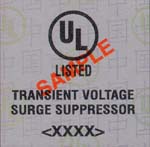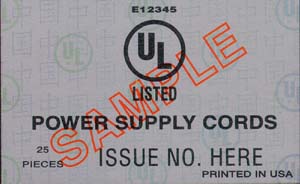





In designated product categories, all UL clients in China will be required to use a newly designed holographic Listing Mark for products manufactured after Nov. 1. UL developed the new label to help deter unauthorized use of the UL Mark after uncovering repeated incidents of counterfeit labeling on certain products exported from China to the United States. The new label should provide protection for consumers and give equal marketing opportunities to all manufacturers whose products comply with UL’s safety requirements.
The products involved include cord sets and power supply cords; current taps; ceiling fans; electric fans; incandescent fixtures; recessed incandescent fixtures; portable lamps; night lights; work lights; clock-operated switches; photoelectric switches; power taps; transformers; transient voltage surge suppressors; and flexible power cords. UL’s evaluation of certain improperly marked samples of these products from China indicates they may present shock or fire hazards and do not comply with UL’s Standards for Safety.
The new holographic labels have a silver base, Chinese characters that form the “China” symbol, and multicolored UL Marks that appear to “float” over the background as light reflects from different angles. The floating elements - the holographs - help to prevent counterfeiting of the labels.
Although counterfeiting instances involve only a small percentage of the 9 billion UL Marks placed on products each year, Joe Bhatia, UL vice president - Follow-Up Services, expresses his concern. “Any counterfeiting can affect the confidence manufacturers, consumers and others have in UL,” he said. “UL takes all appropriate steps to protect the integrity of its Mark, which is why we developed the holographic label. Holographic labels are easy for consumers, retailers and importers to identify and significantly more difficult to alter or forge.”
To implement the program, all Chinese manufacturers in the product categories involved were contacted and informed of the marking requirement change. In addition, UL is informing retailers, distributors, importers, U.S. Customs and other governmental organizations of the new holographic label that will be required on UL Listed products from China after the Nov. 1 deadline.
“In addition to implementing the new holographic label campaign, UL will continue to randomly select samples from production lines and from the marketplace to verify that products bearing the UL Mark continue to meet UL’s Standards for Safety,” said Bhatia.
For more information on the holographic Mark for products made in China, call Mario Xerri in Melville, N.Y., at (516) 271-6200, ext. 22941; fax him at (516) 271-8259; or send him an e-mail message at xerrim@ul.com.
Bogus designer jeans, bootleg compact discs, black market copies of popular Western videos. Over the past decade, imported counterfeit products have flooded U.S. markets, costing American industry billions of dollars each year.
Equally disturbing is the fact that some consumer goods - primarily inexpensive, mass-produced fans, lamps and other electrical devices from China - carry counterfeit UL Marks.
Although counterfeiting involves a very small fraction of the 9 billion UL Marks placed on products each year, it's not something UL takes lightly. Besides jeopardizing the safety of the public, manufacturers who counterfeit UL Marks place UL clients at an unfair competitive disadvantage. For these reasons, UL has developed an aggressive strategy to deal with counterfeiters.
Part of the strategy requires UL clients in China to use newly designed holographic Listing Marks on selected types of products manufactured after Nov. 1, 1996 (as reported in On the Mark, Vol. 2, No. 2). Products that have been found to bear counterfeit UL Marks include cord sets and power supply cords, current taps, ceiling fans, electric fans, incandescent fixtures, recessed incandescent fixtures, portable lamps, night lights, work lights, clock-operated switches, photo-electric switches, power taps, transformers, transient voltage surge suppressors, flexible power cords, and decorative-lighting strings.
Stopping counterfeiters cold
Traditionally, UL has relied on market surveys and reports from its own field representatives, competing manufacturers, jurisdictional authorities and consumers to help identify products suspected of carrying counterfeit UL Marks. These sources remain important in identifying counterfeit Marks after they've reached the marketplace, but with the help of the U.S. Customs Service, UL is now going after products bearing counterfeit Marks before they hit retail shelves.
While UL has offered to help the U.S. Customs Service intercept fraudulently marked goods in the past, the agency has become more receptive as the problem has grown significantly, with more and more products now being counterfeited. "Our proactive partnering with law enforcement agencies is a new, viable resource for UL," says Brian Monks, engineering group leader, Follow-Up Services (FUS) at UL's Melville, N.Y., office. "Protecting the public from potentially dangerous merchandise - while not as glamorous as combating drug smuggling or money laundering - fits in very nicely with the mission of the Customs Service."
"They [Customs Service] had never really considered the problem of counterfeit UL Marks," he adds. "But as we continued to bring it to their attention and offered them training on how to identify counterfeit UL Marks, they became more interested in our help. We now have a federal agency squarely on our side."
Since December 1995, UL staff have trained more than 300 Customs Service inspectors at eight U.S. ports on how to spot products that bear counterfeit UL Marks. At least 300 more inspectors will be trained by 1997, with training sessions planned at all ports of entry.
As part of the training, Customs agents receive UL's easy-to-use, pocket-sized "Enforcement Manual," which contains information and reproductions of legitimate UL Marks. UL also provides Customs with names of known label counterfeiters for its database. Agents can access the data from any U.S. port.
And anti-counterfeiting efforts are paying off. In less than a year, U.S. Customs, working closely with UL, has seized more than $1 million in goods with counterfeit Marks. Much of the merchandise seized has been or will soon be destroyed - a penalty that would-be counterfeiters will probably not ignore, Monks comments.
UL's campaign continues to gain momentum - and a lot of attention. At Customs' Intellectual Property Rights Conference this year, UL's booth was overrun by agents representing a variety of law enforcement organizations, including the FBI, CIA and Interpol, as well as representatives from private industry.
"Without any urging from us, the San Francisco Customs office gave its own presentation on counterfeit UL Marks at the conference," Monks says. "It sparked interest, and we were inundated with questions from people visiting our booth. Staff from Disney and Warner Brothers were more interested in our display than their own, and even Microsoft was impressed with our manual."
The bottom line
Along with training U.S. Customs agents, UL staff are providing additional training for more than 80 UL field representatives in China and FUS field report reviewers at other offices to curtail counterfeiting activity. While this work isn't inexpensive for UL, acknowledges Bob Crane, FUS managing engineer at UL's Research Triangle Park, N.C., office, it would be far more damaging to lose the integrity of the UL Mark.
"Our primary concern is not the money," Crane says. "Safety, client service and the integrity of UL's certification program are our ultimate goals. Consumers look for the UL Mark on products." And UL clients want the maximum value from their legitimate use of the UL Mark on their products, without facing illegal, "counterfeit" competition.
 Back to Main Page
Back to Main Page
 ® Registered trademark of Underweriters Laboratories, Inc.
® Registered trademark of Underweriters Laboratories, Inc. ® is P. Leo & Co.,(B.C.) Ltd. trade mark.
® is P. Leo & Co.,(B.C.) Ltd. trade mark.
